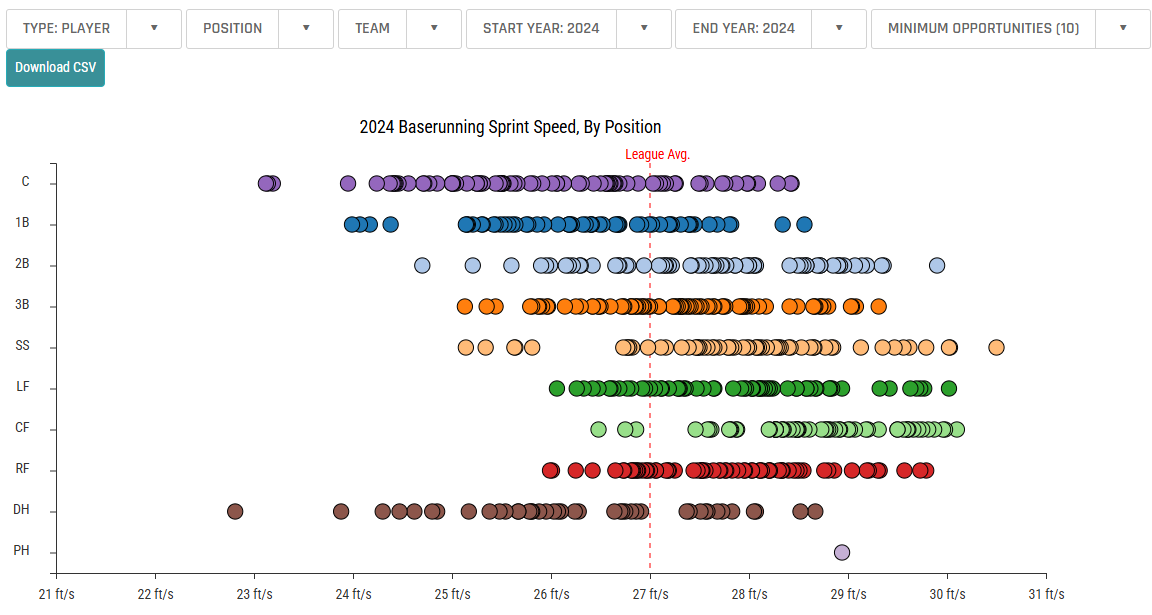Pitchers are throwing faster. Hitters are swinging faster. And players are running faster in the modern era of baseball.
The numbers are readily tracked with modern technology such as Statcast and Trackman, and also more achievable with training methodologies overseen by individuals within the Professional Baseball Strength and Conditioning Coaches Society (PBSCCS) and technologies such as 1080.
Unleashing the Heat
Much of the attention about speed in baseball has centered on the pitching mound, where the average MLB fastball speed has increased from around 89 mph in 2002 to 91.9 mph in 2008 to 94.2 mph in 2023. This year, five pitchers averaged – not just the ability to throw a few pitches at 100+ mph BUT averaged 100+ mph. At the top of the list was rookie Ben Joyce who averaged 102.1 mph and hurled a 105.5 mph fastball on Sept 4 vs the LA Dodgers.
Barreling It Up
On the other end of these flamethrowers is the hitter – 60 feet 6 inches away. From the time the ball leaves the pitcher’s hand until it gets to the plate is literally in the blink of an eye. A 100 mph fastball takes about 375-400 milliseconds, or less than half a second, to reach home plate from the pitcher’s mound. In this time frame, the hitter must identify the ball, process its speed, spin and trajectory and decide whether to swing or not.
In terms of the swing, a tremendous amount of power is being developed throughout the kinetic chain – and ultimately being unleashed into the bat. Modern technology allows tracking of several metrics at the ballpark, including what is called ‘exit velocity’. Data from MLB Statcast indicates that the average batted ball exit velocity is about 88.5 mph. In 2024, there were 85 players with an average exit velocity of 90+ mph, with the NY Yankees Aaron Judge leading the way at 96.2 mph. The hardest-hit ball this season was by Oneil Cruz at a blistering 121.5 mph!
Rotational Power: A Key to Throwing and Hitting
Research studies show a significant correlation between rotational power, usually measured by rotational medicine ball throw, and both pitching and bat swing velocities. For example, a 2021 paper in the Journal of Strength and Conditioning Research by Taniyama and colleagues showed that a moderate correlation (r=0.65) between rotational medicine ball throw velocity and pitching velocity (r=0.62) and bat swing velocity (r=0.65) in NCAA Division III baseball players. Training studies using the medicine ball have also shown an increase in throwing and hitting velocities.
The 1080 Quantum Syncro is a versatile tool that can be used to enhance rotational strength, speed, and power both concentrically and eccentrically along the Force-Velocity curve. In addition, it provides real-time metrics.
Burning Up the Basepaths
The MLB average speed for a “competitive run” – either 1) runs of two bases or more on non-homers, excluding being a runner on second base when an extra base hit happens, or 2) home to first runs on “topped” or “weakly hit” balls – is 27 ft/sec (18.4 mph or 8.23 m/s).
The top speedsters averaged 30 ft/sec or 20.5 mph, which Statcast also calls a “Bolt”. Six players averaged 30 ft/sec and the KC Royals Bobby Witt, Jr. tops the charts at 30.5 ft/sec including 152 Bolts. The graph below shows clear trends by position and individual variation within a position (i.e. some C and 1B are faster than some CF).

Shohei Ohtani’s Historic Season of 50 Home Runs and 50 Stolen Bases
Speed and Power. The combination of running speed and home run power.
In the history of baseball, we have seen the big power hitters (Ruth, McGuire, Judge) and the speedy fleet-footed base stealers (Brock, Coleman, Henderson) but being able to produce big numbers in both categories is challenging. The 30–30 club is the group of 47 ballplayers with Ken Williams, an outfielder for the St Louis Cardinals, first achieving the mark in 1922. He remained the sole member of the club for until the great Willie Mays joined him for consecutive 30–30 seasons in 1956 and 1957.
Although Willie Mays and Bobby Bonds came close, Jose Canseco became the first member of the 40-40 club in 1988. Five others have since joined the 40-40 club including Shohei Ohtani. Not only is Ohtani in the 40-40 club but he also became the first to ever eclipse the 50-50 mark during the 2024 season with 54 HR and 59 SB.
Jack Harris of the LA TImes saw it coming when he wrote the February 26th article – Posed for Improvement? Why Shohei Ohtani could be an even bigger offensive threat in 2024 (link to article: https://www.latimes.com/sports/dodgers/story/2024-02-26/dodgers-shohei-ohtani-possible-offensive-improvement
The article starts “Of all the tools at the disposal of the Dodgers’ player performance department, a small rectangular machine called 1080 Sprint is one of their preferred methods for improving quickness and speed.”
Ready, set, Sho. pic.twitter.com/XUpwAbZGLE
— Los Angeles Dodgers (@Dodgers) January 29, 2024
Ohtani’s Statcast numbers show an average sprinting speed of 28.1 ft/sec and an average exit velocity of 95.8 mph with a max of 119.2 mph. As Dodgers’ special assistant Ron Roenicke stated in the article “He’s just so powerful, with strength and quickness…. you don’t see that very often in baseball, not with that kind of speed and strength. It’s different. He’s a different athlete.”
And let’s not forget the Ohtani can be dominate on the mound as well throwing an average fastball of 96.8 mph.
Enjoy the playoffs – and don’t blink, you might miss something …. like a 100 mph fastball or 120 mph line drive or 30 feet per second bolt of lightning running down the basepath!






























































